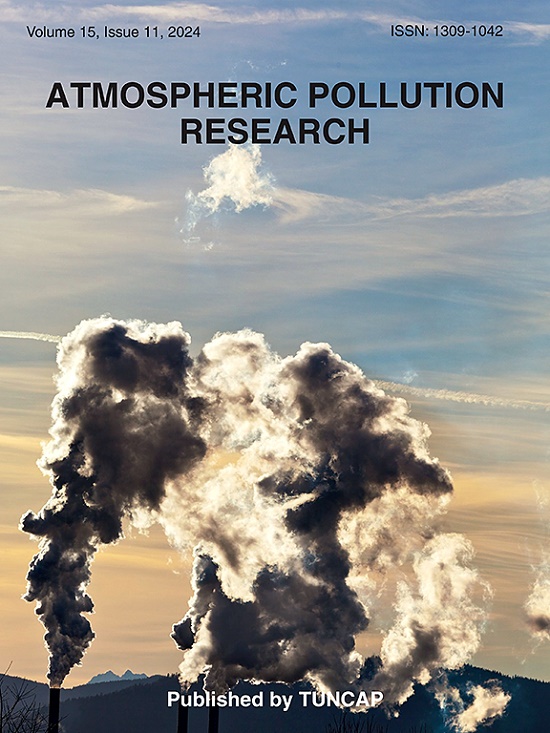Identification and semi-quantification of alkylated polycyclic aromatic hydrocarbons in PM2.5 filter samples using in-injection port thermal desorption coupled with two-dimensional gas chromatography and rapid-scanning quadrupole mass spectrometry (TD-GC×GC-qMS)
IF 3.5
3区 环境科学与生态学
Q2 ENVIRONMENTAL SCIENCES
引用次数: 0
Abstract
Growing evidence suggests that alkylated derivatives of polycyclic aromatic hydrocarbons (PAHs) should be considered in toxicity assessment, necessitating their identification and quantification in ambient air. In this work, we explored the effectiveness of in-injection port thermal desorption coupled with two-dimensional gas chromatography and rapid-scanning quadrupole mass spectrometry (TD-GC × GC-qMS) to detect alkylated PAHs. The reliability of compound identification was carefully evaluated based on detection frequency, retention time consistency, mass spectra similarity to NIST library, and sample-to-sample mass spectral variations. Leveraging the technique's ability to determine low-concentration compounds from complex matrices and to aid in the recognition of homologues via visual inspection, we identified 104 alkylated PAHs in PM2.5 samples collected in Beijing, China. These include 3-ring and 4-ring PAHs with a higher level of alkylation of 3–4 carbon atoms. Our results demonstrated the presence of diverse isomeric structures of alkylated PAHs in ambient PM2.5, with their concentrations exceeding those of their parent PAHs for smaller PAHs but being lower for larger ones. The contribution of alkylated PAHs to the health risk of PAHs was around 5 % in our samples using the toxicity equivalency factor method. The findings of this study underscore the importance of alkylated PAHs in PM2.5 and highlight the potential of TD-GC × GC-qMS in advancing research on profiling toxicants in atmospheric aerosols. Given the widespread availability of qMS and the ease of implementing GC × GC through a solid-state thermal modulator, we recommend the adoption of TD-GC × GC-qMS in the analysis of aerosol samples. This approach enables quantification and isomer-specific analysis of a broader range of alkylated PAHs with improved accuracy.

进样口热解吸-二维气相色谱-快速扫描四极杆质谱联用技术对PM2.5过滤样品中烷基化多环芳烃进行半定量鉴定(TD-GC×GC-qMS)
越来越多的证据表明,在毒性评估中应考虑多环芳烃(PAHs)的烷基化衍生物,有必要在环境空气中对其进行鉴定和量化。在这项工作中,我们探索了注射口热解吸结合二维气相色谱和快速扫描四极杆质谱(TD-GC × GC-qMS)检测烷基化多环芳烃的有效性。根据检测频率、保留时间一致性、质谱与NIST文库的相似性以及样品间质谱的变化,仔细评估了化合物鉴定的可靠性。利用该技术从复杂基质中确定低浓度化合物的能力,并通过目视检查帮助识别同源物,我们在中国北京收集的PM2.5样本中鉴定了104个烷基化多环芳烃。这些包括3-4环和4环多环芳烃,它们的3-4个碳原子的烷基化程度更高。结果表明,环境PM2.5中存在多种异构结构的烷基化多环芳烃,较小的多环芳烃浓度高于母体多环芳烃,较大的多环芳烃浓度低于母体多环芳烃。采用毒性等效因子法,烷基化多环芳烃对我们样本中多环芳烃健康风险的贡献约为5%。本研究结果强调了PM2.5中烷基化多环芳烃的重要性,并强调了TD-GC × GC-qMS在推进大气气溶胶中毒物分析研究中的潜力。考虑到qMS的广泛使用以及通过固态热调制器实现GC × GC的易用性,我们建议在气溶胶样品分析中采用TD-GC × GC-qMS。这种方法可以对更广泛的烷基化多环芳烃进行定量和异构体特异性分析,并提高准确性。
本文章由计算机程序翻译,如有差异,请以英文原文为准。
求助全文
约1分钟内获得全文
求助全文
来源期刊

Atmospheric Pollution Research
ENVIRONMENTAL SCIENCES-
CiteScore
8.30
自引率
6.70%
发文量
256
审稿时长
36 days
期刊介绍:
Atmospheric Pollution Research (APR) is an international journal designed for the publication of articles on air pollution. Papers should present novel experimental results, theory and modeling of air pollution on local, regional, or global scales. Areas covered are research on inorganic, organic, and persistent organic air pollutants, air quality monitoring, air quality management, atmospheric dispersion and transport, air-surface (soil, water, and vegetation) exchange of pollutants, dry and wet deposition, indoor air quality, exposure assessment, health effects, satellite measurements, natural emissions, atmospheric chemistry, greenhouse gases, and effects on climate change.
 求助内容:
求助内容: 应助结果提醒方式:
应助结果提醒方式:


